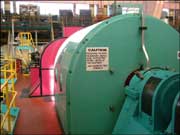9. The Electrical Generator
A
generator produces electricity. It is made of two main parts, the Stator
and the Rotor. The speed of the generator must be kept constant .
The Stator
The Stator stays still and surrounds the rotor.
- It has large coils of wire
- Its coils create electricity when a magnetic field "cuts" them.
The Rotor
The Rotor rotates and is in the centre of the generator.
- It is on a steel shaft that spins
- It is made to spin by the steam turbine
- It has coils of wire which become a magnet
A generator can be made more powerful by
- increasing the number of turns of wire
- increasing the strength of the magnetic field, or flux
- spinning the rotor faster
At Waikarei the speed of the turbine is controlled by ‘governors’. If a great deal of electricity is needed the governor supplies extra steam. The extra steam drives the generator harder producing more electricity.
Some factors that affect the electricity supply are
- The time of day and demand for electricity
- The seasons
- Weather changes
- What other power stations are doing
- The Cook Strait cables
- Damage to the National Grid
It is a constant juggling act, between all the power stations in NZ to keep the electricity supply the same.



